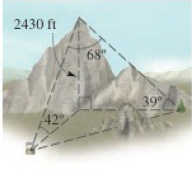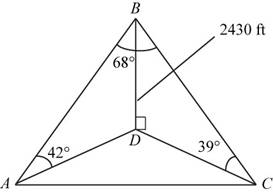
Concept explainers
Determining a Distance A surveyor has determined that a mountain is 2430 ft high. From the top of the mountain he measures the angles of depression to two landmarks at the base of the mountain and finds them to be 42º and 39°. (Observe that these are the same as the angles of elevation from the landmarks as shown in the figure at the left.) The angle between the lines of sight to the landmarks is 68º. Calculate the distance between the two landmarks.

The distance between the two landmarks.
Answer to Problem 6P
The distance between the two landmarks is
Explanation of Solution
Given:
The height of the mountain is
Calculation:
Assume the triangle ABC as given below with the given specifications,

Figure (1)
Use trigonometric ratio of sine in triangle ABD to calculate the value of AB with respect to Figure (1),
The length of side AB is 3631.58.
Use trigonometric ratio of sine in triangle BDC to calculate the value of BC with respect to Figure (1),
The length of side BC is 3861.31.
The cosine law is,
Substitute AC for a, 3861.31 for b, and 3631.58 for c, and
Further solve the above expression.
Thus, the distance between the two landmarks is
Chapter 6 Solutions
Precalculus: Mathematics for Calculus - 6th Edition
- 3. Mary needs to choose between two investments: One pays 5% compounded annually, and the other pays 4.9% compounded monthly. If she plans to invest $22,000 for 3 years, which investment should she choose? How much extra interest will she earn by making the better choice? For all word problems, your solution must be presented in a sentence in the context of the problem.arrow_forward4 πT14 Sin (X) 3 Sin(2x) e dx 1716 S (sinx + cosx) dxarrow_forwardLet g(x) = f(t) dt, where f is the function whose graph is shown. 3 y f(t) MA t (a) At what values of x do the local maximum and minimum values of g occur? Xmin = Xmin = Xmax = Xmax = (smaller x-value) (larger x-value) (smaller x-value) (larger x-value) (b) Where does g attain its absolute maximum value? x = (c) On what interval is g concave downward? (Enter your answer using interval notation.)arrow_forward
- 2. Graph the function f(x)=e* −1. Label three points on the graph (one should be the intercept) with corresponding ordered pairs (round to one decimal place) and label the asymptote with its equation. Write the domain and range of the function in interval notation. Make your graph big enough to see all important features. You may show the final graph only.arrow_forwardansewer both questions in a very detailed manner . thanks!arrow_forwardQuestion Considering the definition of f(x) below, find lim f(x). Select the correct answer below: -56 -44 ○ -35 ○ The limit does not exist. x+6 -2x² + 3x 2 if x-4 f(x) = -x2 -x-2 if -4x6 -x²+1 if x > 6arrow_forward
- Let g(x) = f(t) dt, where f is the function whose graph is shown. y 5 f 20 30 t (a) Evaluate g(x) for x = 0, 5, 10, 15, 20, 25, and 30. g(0) = g(5) = g(10) = g(15) =| g(20) = g(25) = g(30) = (b) Estimate g(35). (Use the midpoint to get the most precise estimate.) g(35) = (c) Where does g have a maximum and a minimum value? minimum x= maximum x=arrow_forwardQuestion Determine lim f(x) given the definition of f(x) below. (If the limit does not exist, enter DNE.) x+6+ -2x²+3x-2 f(x) -2x-1 if x-5 if -−5≤ x ≤ 6 3 if x 6arrow_forwardQuestion Given the following piecewise function, evaluate lim f(x). (If the limit does not exist, enter DNE.) x-3 Provide your answer below: x² + 3x 3 if x-3 f(x) -3 if -3x -2x²+2x-1 6 if x 6arrow_forward
- Question Given the following piecewise function, evaluate lim f(x). x→2 Select the correct answer below: -73 -24 -9 -12 The limit does not exist. 2x f(x) = -2x²-1 if -2x2 3x+2 if x 2arrow_forwardQuestion Given the following piecewise function, evaluate lim f(x). f(x) = x+1- -2x² - 2x 3x-2 2 x² +3 if x-2 if -2< x <1 if x 1 Select the correct answer below: ○ -4 ○ 1 ○ 4 The limit does not exist.arrow_forwardQuestion Given the following piecewise function, evaluate lim →1− f(x). Select the correct answer below: ○ 1 ○ 4 -4 The limit does not exist. -2x² - 2x x 1arrow_forward
 Calculus: Early TranscendentalsCalculusISBN:9781285741550Author:James StewartPublisher:Cengage Learning
Calculus: Early TranscendentalsCalculusISBN:9781285741550Author:James StewartPublisher:Cengage Learning Thomas' Calculus (14th Edition)CalculusISBN:9780134438986Author:Joel R. Hass, Christopher E. Heil, Maurice D. WeirPublisher:PEARSON
Thomas' Calculus (14th Edition)CalculusISBN:9780134438986Author:Joel R. Hass, Christopher E. Heil, Maurice D. WeirPublisher:PEARSON Calculus: Early Transcendentals (3rd Edition)CalculusISBN:9780134763644Author:William L. Briggs, Lyle Cochran, Bernard Gillett, Eric SchulzPublisher:PEARSON
Calculus: Early Transcendentals (3rd Edition)CalculusISBN:9780134763644Author:William L. Briggs, Lyle Cochran, Bernard Gillett, Eric SchulzPublisher:PEARSON Calculus: Early TranscendentalsCalculusISBN:9781319050740Author:Jon Rogawski, Colin Adams, Robert FranzosaPublisher:W. H. Freeman
Calculus: Early TranscendentalsCalculusISBN:9781319050740Author:Jon Rogawski, Colin Adams, Robert FranzosaPublisher:W. H. Freeman
 Calculus: Early Transcendental FunctionsCalculusISBN:9781337552516Author:Ron Larson, Bruce H. EdwardsPublisher:Cengage Learning
Calculus: Early Transcendental FunctionsCalculusISBN:9781337552516Author:Ron Larson, Bruce H. EdwardsPublisher:Cengage Learning





